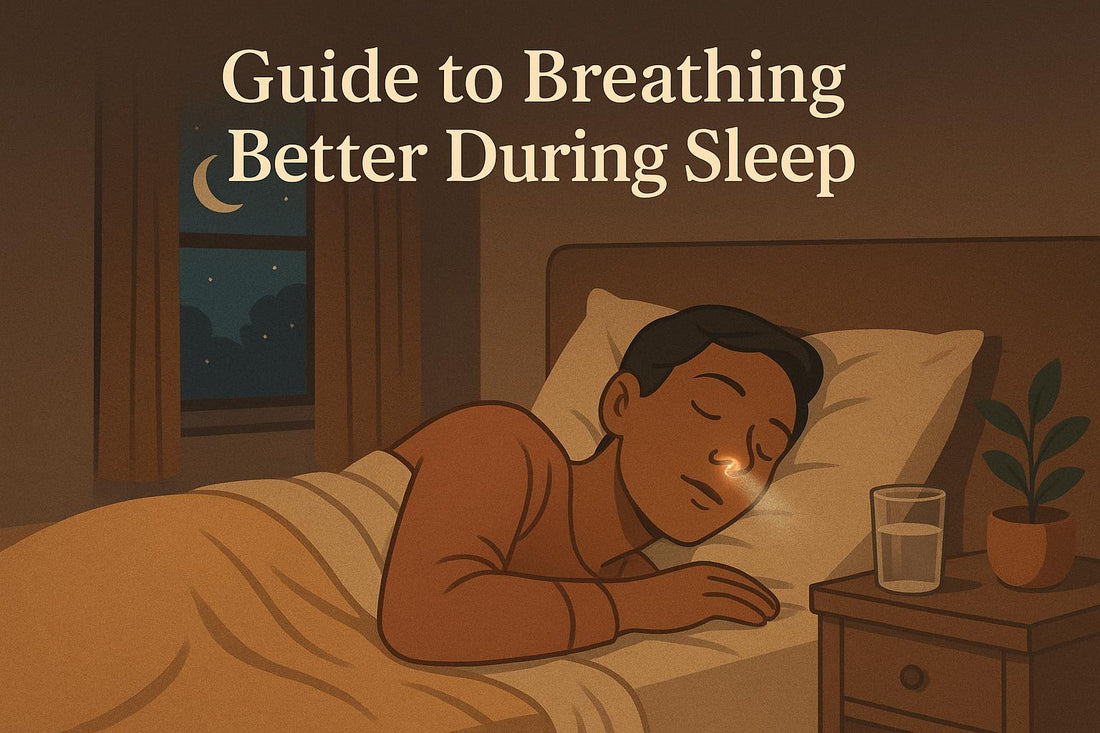
Guide to Breathing Better During Sleep
Share
Want better sleep? Start with your breathing. Nasal breathing during sleep improves oxygen flow, reduces snoring, and helps you wake up feeling refreshed. Mouth breathing, on the other hand, disrupts deep sleep, dries out airways, and can lead to health issues like snoring or sleep apnoea.
Here's how to improve your breathing for better rest:
- Use nasal strips: They open nasal passages for easier airflow.
- Practise breathing exercises: Strengthen your diaphragm and airway muscles.
- Address nasal congestion: Clear blockages to prevent mouth breathing.
- Adopt good sleep habits: Sleep on your side and keep your room allergen-free.
Struggling with Nasal Breathing at Night? Here's How to Fix It!
How Nasal Breathing Helps During Sleep
Your nose plays a key role in promoting better sleep through its specialised breathing functions. Knowing how nasal breathing works can guide better choices for nighttime breathing habits.
How Nasal Breathing Works
Breathing through your nose helps filter out harmful particles, adds moisture to the air, and regulates airflow. It also increases nitric oxide production, which improves oxygen circulation and supports muscle recovery. These functions prepare the air before it reaches your lungs, contributing to better sleep. On the other hand, breathing through your mouth bypasses these benefits.
Issues Caused by Mouth Breathing
Switching from nasal to mouth breathing during sleep can lead to several problems that disrupt rest:
| Problem | Effect on Sleep |
|---|---|
| Lower Oxygen Levels | Mouth breathing can reduce CO2 levels, affecting oxygen uptake |
| Dry Throat | Lack of moisture can cause irritation and inflammation |
| Increased Risk of Infection | Skipping nasal filtration allows more particles into the lungs |
| Slower Muscle Recovery | Reduced nitric oxide impacts the body's ability to recover overnight |
Why Nasal Breathing Matters for Sleep
Keeping nasal breathing steady during sleep helps optimise oxygen delivery and supports respiratory muscle function. It also deepens sleep by improving oxygen flow and engaging the parasympathetic system, which calms the body and aids recovery. These factors highlight the importance of addressing nighttime breathing habits for better rest.
Main Nighttime Breathing Problems
Understanding common nighttime breathing problems can help address sleep issues and improve overall rest.
Effects of Nasal Congestion
Nasal congestion can disrupt sleep by limiting airflow through the nasal passages. When the nose is blocked, the body often shifts to mouth breathing, which bypasses the nose's natural ability to filter and humidify air.
Here are some signs that nasal congestion might be affecting your sleep:
| Symptom | Impact on Sleep |
|---|---|
| Morning Headaches | May lead to throat irritation |
| Brain Fog | Could result from poor air quality |
| Daytime Fatigue | Suggests interrupted sleep cycles |
| Hoarse Voice | Linked to extended periods of mouth breathing |
Blocked nasal passages not only reduce airflow but can also lead to snoring and even sleep apnoea. This creates a cycle of poor-quality sleep and breathing difficulties.
Snoring and Sleep Apnoea Stats in Australia
Sleep-disordered breathing is a common issue for many Australians, with impacts that go beyond just feeling tired. These issues can affect daily productivity and even long-term health.
Signs of nighttime breathing problems include dark circles, sleeping with an open mouth, bad breath in the morning, and persistent fatigue. Many people are unaware of their mouth breathing until these symptoms become noticeable.
Ways to Breathe Better at Night
Clearing your nasal passages can make a big difference in addressing common sleep problems. By focusing on improving airflow, you can enjoy uninterrupted breathing throughout the night. One effective option is BWLL Nasal Strips, which help open up your nasal passages naturally. Let’s take a closer look at how they can enhance your sleep experience.
How BWLL Nasal Strips Help

BWLL Nasal Strips work by gently lifting and opening your nasal passages, making it easier to breathe while you sleep. This drug-free solution offers immediate relief and is designed for comfort.
Here’s what they offer:
| Feature | Duration | Benefit |
|---|---|---|
| Instant Airflow | Up to 18 hours | Easier breathing through the night |
| Gentle Adhesion | All night | Comfortable and secure fit |
| Drug-Free Relief | Immediate | Safe, natural breathing aid |
sbb-itb-dc10090
Breathing Training Methods
Boost your breathing muscles with simple daily exercises to help improve your sleep.
Daily Nose Breathing Exercises
Practising diaphragmatic breathing every day can strengthen your diaphragm and encourage efficient nasal breathing. Try this easy technique before bedtime:
Diaphragmatic Breathing Exercise
- Lie down comfortably, placing one hand on your stomach and the other on your chest.
- Close your mouth and rest your tongue gently on the roof of your mouth.
- Inhale slowly through your nose, noticing your stomach rise.
- Exhale through your mouth, allowing your stomach to fall.
- Repeat for about 10 minutes, keeping a steady breathing rhythm.
Mouth and Throat Exercises
Strengthening the muscles in your mouth and throat can help keep your airway open during sleep. These exercises work on the tongue, soft palate, and surrounding muscles, reducing the chance of airway obstruction.
| Exercise Type | Method | Benefit |
|---|---|---|
| Tongue Toning | Press softened chewing gum against the palate | Helps maintain proper tongue position |
| Soft Palate | Perform a "closed mouth yawn" | Tones the palatoglossus muscle |
| Airway Muscles | Blow through a small straw | Strengthens muscles to prevent collapse |
"To keep the airway open and primed for a good night of breathing and a good night of sleep, we must: Keep the mouth closed. Keep the tongue toned to rest properly up in the palate. Keep the soft palate toned to prevent collapse back into the airway. Keep the superior constrictor muscles toned to resist inward collapse." - Dr. Mindy, Apex Dental
Natural Strengthening Methods
Incorporate these simple habits into your routine to naturally strengthen your airway muscles:
- Snack on crunchy foods like carrots and celery.
- Use silicone chewing exercisers for added toning.
- Practise pursed-lip breathing.
- Try a breath trainer with adjustable resistance.
These techniques can support a clearer airway, helping you enjoy uninterrupted, restorative sleep.
Sleep Breathing Solutions Guide
Improving nighttime breathing can be straightforward. By focusing on nasal breathing and incorporating specific exercises, you can enhance your sleep quality. Here's a look at one effective solution.
BWLL Nasal Strips Features
BWLL Nasal Strips provide a drug-free way to support better breathing while you sleep.
Key Features:
- Strong, medical-grade adhesive for a secure hold
- Gentle, hypoallergenic materials suitable for sensitive skin
- Safe for use during pregnancy
- Packaged in recyclable, environmentally friendly materials
- Designed for optimal comfort and effective nasal lift
Pairing these strips with proper sleep positions and regular breathing exercises can lead to noticeable improvements in your rest.
How to Use BWLL Nasal Strips
Follow this nightly routine to get the most out of your BWLL Nasal Strips:
| Time | Step | Why It Helps |
|---|---|---|
| Evening | Wash your face thoroughly | Ensures the strip adheres properly |
| 30 mins before bed | Apply the nasal strip | Gives the adhesive time to set |
| During sleep | Strip keeps nasal passages open | Promotes steady airflow |
| Morning | Remove gently after washing | Avoids skin irritation |
Tips for Best Results:
- Apply the strip to clean, dry skin.
- Position it just above the nostril flare.
- Press firmly along the edges to secure it.
- Use a fresh strip each night.
To further enhance your sleep, maintain a tidy sleeping area and continue practising the breathing exercises mentioned earlier. Consistent use of these methods can make a noticeable difference in how well you sleep.
Conclusion: Better Sleep Through Better Breathing
Good nasal breathing plays a key role in achieving restorative sleep and maintaining overall health, especially when paired with tools like BWLL Nasal Strips.
Breathing through your nose ensures a steady oxygen flow during sleep, minimises issues linked to mouth breathing, and boosts energy levels during the day. Combined with consistent breathing habits, this creates a solid base for quality rest.
BWLL Nasal Strips offer a simple, drug-free way to support nasal breathing. By gently lifting the nasal passages, they help keep airflow smooth and natural. Using them regularly can make a noticeable difference in your nightly routine.
For the best results, pair these strips with healthy sleep practices. Here’s a quick reminder of what to include:
- Apply a BWLL Nasal Strip before going to bed
- Keep your sleeping area clean and free from allergens
- Use sleep positions that encourage proper breathing
- Incorporate breathing exercises into your routine
Making these steps part of your nightly habits can lead to long-term improvements in sleep quality.
FAQs
How can I tell if I’m breathing through my mouth while I sleep, and what are the signs to watch for?
Mouth breathing during sleep can often be identified by a few common signs. If you wake up with a dry mouth, bad breath, a scratchy or dry throat, or a hoarse voice, it may indicate that you’re breathing through your mouth at night.
Other signs include feeling fatigued, irritable, or not well-rested upon waking. These symptoms can occur because mouth breathing reduces airflow efficiency and may disrupt your sleep quality. Paying attention to these indicators can help you address any issues and improve your breathing for better rest.
What exercises can help strengthen airway muscles and support better nasal breathing during sleep?
To strengthen your airway muscles and improve nasal breathing, try a simple nose-clearing exercise. Start by breathing normally through your nose, then take a deep breath in and out. Gently pinch your nostrils closed with your fingers and hold your breath for as long as you comfortably can while nodding your head. Once you release your nostrils, resume breathing gently through your nose.
Incorporating this into your daily routine can help train your nasal passages to stay open and improve airflow during sleep. Always listen to your body and avoid overexertion to ensure the exercise remains comfortable and effective.
What makes BWLL Nasal Strips an effective way to improve nasal airflow during sleep?
BWLL Nasal Strips are a simple and effective solution designed to improve nasal airflow, helping you breathe more easily while you sleep. By gently lifting and opening the nasal passages, these strips reduce resistance and promote better airflow, which can lead to a more restful and refreshing sleep.
Unlike other methods that may involve medications or invasive procedures, BWLL Nasal Strips are non-invasive, easy to use, and suitable for nightly use. They are especially helpful for individuals experiencing nasal congestion, snoring, or difficulty breathing through the nose. With their comfortable design and reliable performance, they offer a practical way to enhance your sleep quality and overall well-being.